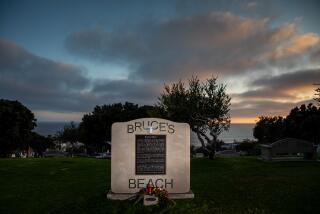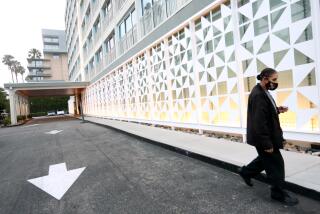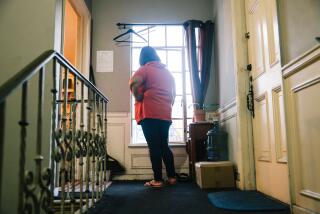Ownership in Cuba Becomes Hot Issue
MIAMI — In the 1950s, when Alberto Beguiristain’s family owned 130,000 acres of farmland, two sugar mills and a distillery in Cuba, their 5,000 employees earned an average of $6 a day.
Now, at the dilapidated mill in Quemado de Guines that is the sole Beguiristain enterprise still functioning, it takes the average laborer almost a month to earn $6.
Beguiristain, who now lives in Miami, says he thinks his former countrymen would welcome his return to run what’s left of the family business if the ailing Fidel Castro dies and Cubans turn toward a democratic government and pro-market economy.
“My cousin went back to our hometown a few years ago,” the 74-year-old insurance agent recalled. Outside the mill gates, the travelers encountered some elderly peasants. “They told her, ‘We need your people. When are you coming back?’ ”
The question of who will own what in a post-Castro Cuba has been an intoxicating subject here since the July 31 news of the president’s surgery and temporary transfer of power to his brother Raul.
But few are as optimistic as Beguiristain that the question could be resolved cleanly and simply.
Beguiristain is one of more than 150,000 Cubans who initially fled the 1959 revolution that brought Fidel Castro’s guerrillas to power. Each family stripped of its property for alleged collaboration with the deposed regime of Fulgencio Batista was usually allowed to take only $5 and the clothes they were wearing.
Many of the exiles have kept tabs on their properties through friends who visit the island, or, like Beguiristain, from the Google Earth program that allows them to see satellite images on the Internet. There they get a glimpse of the time, money and energy needed for restoration.
It has been nearly half a century since Castro’s revolutionaries took control of the Cuban economy. Factories were put under state management, farmland handed to cooperatives, and elegant houses carved up into small apartments and doled out to the poor.
The Communist government settled claims early on with most foreign investors, though not with U.S. owners. There are about 6,000 claims valued at nearly $8 billion registered with the U.S. Foreign Claims Settlement Commission.
But the vast majority of property seized in the name of Castro’s revolution was from Cuban owners, large and small. Though original owners are dying, some survive on dreams of recovering family homes, replanting gardens or rebuilding businesses opened by their ancestors.
Cuban American lawyer Nicolas Gutierrez, whose family was one of the wealthiest in Cuba before the revolution, estimates that at least $100 billion in property was taken from Cuban owners.
Although there is no formal registry of Cuban claims, Gutierrez estimates that at least 2 million people on the island or in exile may have the right, as original owners or their heirs, to claim seized assets or compensation if Cuba is democratized.
“Restitution is not only a pro-exile policy, it’s a pro-Cuban policy. Most former property owners are still on the island,” said Gutierrez, who was born in Miami to exile parents. “We want everyone to get what they lost.”
Cuba has the advantage of learning from the mistakes and successes of new democracies in Eastern Europe, said Tania C. Mastrapa, a Miami consultant on foreign property claims who did her doctoral dissertation on ownership resolution in those post-Communist countries.
How quickly any restitution or compensation program could be enacted in Cuba depends on when and what kind of change occurs, Mastrapa said.
Flocks of former owners have descended on Mastrapa’s practice in recent weeks, newly encouraged that political change is coming in Cuba because of the illness and incapacitation of 80-year-old Castro.
“I try to get my clients to hope for the best but to expect the worst,” she said.
Even if transition is swift and thorough, a Communist-controlled judiciary will probably still be in power during the crucial early days -- and therefore in charge of administering privatization and setting terms for resolving multiple claims and ethical conflicts.
In Eastern Europe, private ownership has been restored with an array of privatization, restitution and compensation programs.
In Latvia, residential property that had been seized from owners after the 1940 Soviet takeover was occupied -- sometimes for decades -- by other families.
The new Latvian government crafted a seven-year property ownership transition period after the country broke from the Soviet Union in 1991, leaving original owners and occupants to negotiate rents or buyouts and providing arbitration for the few irreconcilable cases.
Mastrapa conducted an informal survey of Cuban exiles with property claims. She said she was surprised to learn that most would be willing to accept some other form of compensation if their property was irreparable or being used for a socially redeeming purpose. Only 23% insisted on restitution.
Over the years, Cuba’s government has equated any steps toward capitalism with an invasion of property-grabbing exiles. Some exiles with more recent experience of life on the island warn that the property issue is hypersensitive and that owners should come to terms with their losses.
“It’s a page in ancient history, and it would be sheer madness from the political standpoint to be making claims,” said Domingo Amuchastegui, a former Cuban intelligence official who defected in 1994.
Restoring private property and settling outstanding claims are among the transitional issues addressed in the 2004 report by the U.S. Commission for Assistance to a Free Cuba, which lays out over nearly 450 pages Washington’s priorities for rebuilding democratic and free-market institutions in Cuba.
Amuchastegui criticized the Bush administration report as presumptuously advising Cubans on what reforms they should undertake, and he warned that it fed into the Castro regime’s propaganda meant to frighten Cubans about change.
“The U.S. government, if requested by a transition Cuban government, could help establish a structure for addressing property expropriations,” the report says, detailing a legal and judicial process for Cubans to follow.
Cuban American social leaders agree the issue is delicate and divisive.
“Cuban exiles are not going to go back and boot people out of their homes,” said Alfredo Mesa, executive director of the Cuban American National Foundation.
Attorney Gaston Cantens represents the Fanjul family, which lost sugar mills, farmland and homes in Cuba but rebuilt in Palm Beach County into Florida Crystals, the state’s largest sugar producer. Cantens says that recovering property is “in the back of everyone’s mind,” but that most exiles are more focused on seeing democracy brought to their native land.
Recalling the Eastern European success in restoring property, Cantens added: “I can’t imagine in Cuba there is not going to be a similar process. But I don’t think you’re going to have people knocking on doors saying, ‘This is my home, you’ve got to leave.’ ”
Still, it remains uncertain whether, when and what kind of change is ahead for Cuba -- a Western-style democracy, the Chinese model or some hybrid.
Though most former owners are in their 70s or older, they refuse to concede that they are unlikely to live to see their properties returned to them.
That hope dies last is evident in the long-nurtured dreams of exiles like Beguiristain to once again see the land of their birth and the backdrop of their youth.
Beguiristain, who moves slowly and with a cane after knee surgery this year, said that he would never displace Cubans from the residential properties his family lost but that he would eagerly return to a free Cuba to try to breathe life into his family’s dying businesses.
“I hope that it is in my lifetime,” he said with a dejected glance at his swollen leg. “I think once it gets going, it’s going to be almost immediately. Once they get an elected government, they’ll need to reconstruct everything.”
He’s ready to leave his spacious home and the comforts he built for himself and his family to be part of that reconstruction, he said, noting that his son’s power boat is gassed up and ready to depart for Havana at the first sign from either government that U.S. investment is welcome on the island.
*
More to Read
Sign up for Essential California
The most important California stories and recommendations in your inbox every morning.
You may occasionally receive promotional content from the Los Angeles Times.











